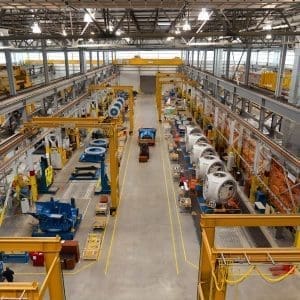As your organization ponders a Digital Transformation, a critical concern will be the creation of Value. But is this value for the Shareholder as we focus on building a Great Stock, or value for Employees and Customers as we build a Great Company? Three separate conversations, focused on three different stakeholders.
As your organization ponders big ideas like a digital transformation, a critical strategic concern for the leadership team will be the creation of value – simply put, what’s in it for me? (or, more accurately, what’s in it for the company?) This can be a more nuanced question than one might expect – are we talking about the value created for the shareholder as we focus on building a Great Stock, or the value created for our employees and our customers as we focus on building a Great Company?
Let’s break this up into three separate conversations, focused on our three different stakeholders …
Value for the Shareholders
Also known as Total Shareholder Return; this is the raw, capitalist form of value creation. There is plenty of information available on what creates long-term shareholder value; in its simplest form, the value of a stock is driven by three basic levers:
- Earnings Growth – The day-to-day operations of a company, creating and selling products at a fair profit. The objective here is to increase cash earnings – and there are many areas where a Digital Business has direct impact on those. Historically, of course, automation of internal Operations has focused on driving down costs; automation also enables a company to scale their processes, efficiently handling an increase in sales volume without a corresponding growth in the cost required to support those sales. Customer-facing Digital efforts will also impact earnings, by driving the quality and volume of sales, gaining share in existing markets and creating new opportunities with new and innovative offerings.
- Capital Efficiency – What does your business do with all the cash from your shareholders, and all the cash generated by operations? This is a lever primarily controlled by the Finance organization; when these folks are buying back stock or restructuring corporate debt, it doesn’t feel like there is a big digital business play. However, when capital is tied up in inventory, invested in manufacturing capacity, or used to make acquisitions of businesses or intellectual property, Digital capabilities will drive return on capital; these will always be a need for efficient digital operations, plus tight collaboration to pull in new people and new capabilities to your team.
- Multiple Expansion – A fancy term for that interesting gap between the imputed value of a company, based on actual performance, versus the current price on the open market. Why are some stocks more highly rated than their peers? What have they done to earn such a high (or low) earnings multiple? Market price can be heavily impacted by the perception of risk and volatility – and the relative performance of your organization versus their peers in the market. Your digital business can and should focus on managing and reducing risk, as every good business would; multiple expansion and market sentiment is quite difficult to predict, better to focus on what you can control in your internal operations, the quality of your customer relationships, and the strength of your products in the market. The rest should take care of itself.
We could drill into many details here, but this basic framework can help us answer our first important question: How are we building a more valuable company, and driving market value, by adding digital capabilities?
Value for the Employees
The counterpoint to a Great Stock is a Great Company – one, for example, where employees have the right skills, the right motivations, and are highly engaged. Employee Engagement is a bit of a buzzword, and when first introduced to an organization, can be a difficult concept to grasp. A basic description of Employee Engagement can be had with three simple questions:
- Do I understand and believe in the purpose of the company – do I know where we are going? Clarity of purpose, and a strong sense of direction, brings value to the employee in the form of a clear individual vision, an affirmation of the values of the company and, hopefully, alignment with the employees personal and professional values.
- Do I get the support I need from my manager? The individual has to shoulder the weight of their roles and responsibilities; this is a job, after all, and not a hobby. Nevertheless, the role of the supervisor / manager is critical, and people expect clear direction, open and honest communication, and solid feedback on their performance.
- Do I have the tools and processes needed to be successful at my job? It can be frustrating and quite disheartening to be expected to deliver when the tools are inadequate and the processes in place seem to just get in the way. A highly engaging environment makes the right investments in tools, and iterates on internal and external processes.
With this simple definition, we ask a set of important questions: How are we defining, refining, and supporting the purpose of the company by adding digital capabilities? Will these changes help or hurt the relationship between teams and their supervisors? And will our employees get the training and support they need to do their very best?
Value for the Customer
There are two parts to our Great Company focus; engaged employees are important, but we exist to create and sell products and services to our customers. A successful digital business has a two out of five important components that are focused on creating value here …
- Connections with Customers – Really listening and understanding their needs, developing products and services that fulfill those needs, and fulfilling them with a fanatical focus on customer service.
- Information in our Products – The introduction of information as a new and differentiating feature in your products and services can truly change your role in the market, your value to the customers. In this component of your digital business, it’s critical to focus on the entire value chain; how can your Product Development and Channel Management teams derive value from this information? What about your channels – OEMs, distributors, dealers, brokers, and everyone involved in getting to the end of that chain – your end customers?
The questions that arise here are important – but not as important as where you get your answers. Digital capabilities make it easier than ever to really listen to your customers, and focus on their needs – but you must turn your attention externally!
A Balanced Response
The thoughtful and observant reader should understand that decisions and directions aimed to improve your Great Company will go counter to the needs of a Great Stock, and vice versa. A short-term focus on quarterly earnings and cash flows may drive the stock value, but can lead to actions that make it tough on employees and customers alike. Can an organization survive long term if we keep slashing costs to maintain earnings growth? The math really doesn’t work, you can only cut so far – and you need engaged teams, creating dynamite products and terrific customer relationships, to deliver sustainable results.
On the other hand – we are running a business here, and there are times when the employee needs the company, and times when the company needs the employee. Some decisions may seem harsh – pivots away from favored customers, fun projects, and exciting markets. And some of these pivots may create change for your teams – change they won’t entirely agree with.
This is typically the time where a strong leadership team adds in to the conversation – with open communication, clarity of purpose, and a focus on maintaining that balance. Great Company, Great Stock … there are plenty of businesses that make this work – but it takes work!
2 December, 2018
- Creating Enterprise Value with your Digital Transformation
- Creating Digital Value for Stock Holders
- Creating Digital Value for Employees
- Creating Digital Value for Customers
- Digital Transformation on the Manufacturing Floor






Comments (2)
Thoughtful piece. I agree that a sustainable business requires the engagement of employees (too many times, intellectual capital is wasted because managers don’t engage all of their resources; underemployment is actually an epidemic.), an obsession with delivering what customers want, and a strong focus on the bottom line.
Under “Value for Employees”, I might suggest that employees also want to make an impact – to contribute and make a difference – and for leadership to demand it, count on it, and recognize it. I think most of the employees you want to hire also want to learn as much as they can. Both of these aspects of employee engagement are often ignored.
I agree – acknowledgement for well focused, impactful results has had a powerful effect on Engagement levels on our team. And it’s insightful to realize that it doesn’t take a crazy amount of effort to do some good – a public callout, a specific email – something to let folks know that yes, you are really paying attention and seeing the results – has a big impact!